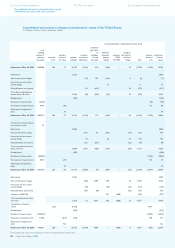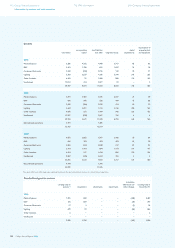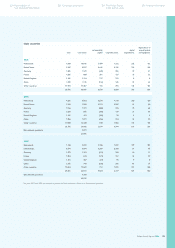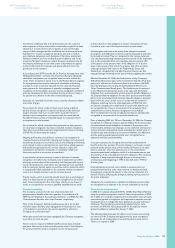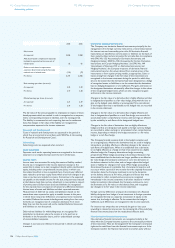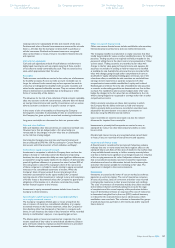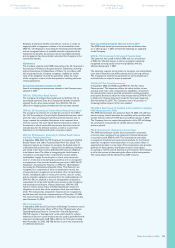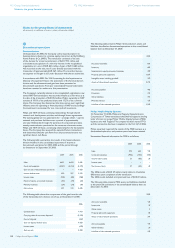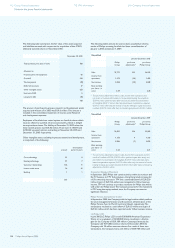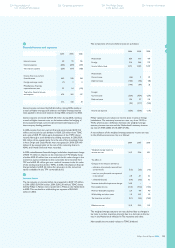Philips 2006 Annual Report Download - page 129
Download and view the complete annual report
Please find page 129 of the 2006 Philips annual report below. You can navigate through the pages in the report by either clicking on the pages listed below, or by using the keyword search tool below to find specific information within the annual report.
Philips Annual Report 2006 129
Employee termination benefi ts covered by a contract or under an
ongoing benefi t arrangement continue to be accounted for under
SFAS No. 112, ‘Employer’s Accounting for Postemployment Benefi ts’
and are recognized when it is probable that the employees will be
entitled to the benefi ts, the amounts can be reasonably estimated,
and management has demonstrably committed the Company to the
termination benefi ts.
Guarantees
The Company complies with FASB Interpretation No. 45, ‘Guarantor’s
Accounting and Disclosure Requirements for Guarantees, including
Indirect Guarantees of Indebtedness of Others’.
In accordance with
this interpretation, the Company recognizes a liability for the fair
value of the obligation incurred for guarantees within the scope
of the recognition criteria of the Interpretation, including minimum
revenue guarantees.
Accounting standards adopted in 2006
Several accounting pronouncements relevant to the Company were
adopted in 2006:
SFAS No. 123(R), ‘Share-Based Payment’
The Company has adopted the amendments to SFAS No. 123 on
share-based payments. Since the Company had already voluntarily
adopted the fair value measurements from SFAS No. 123, the
effects from adopting these amendments have not been material.
SFAS No. 155 ‘Accounting for Certain Hybrid Financial Instruments’
The Company has elected not to adopt the provisions from SFAS
No. 155 ‘Accounting for Certain Hybrid Financial Instruments’ which
allow fair value accounting for hybrid fi nancial instruments and no
longer requires the embedded derivatives to be separated from
the host contract. The main hybrid fi nancial instruments relate to
divestments in which convertible instruments have been issued as
consideration for the divested activities, as well as to personnel
debentures in the Netherlands with a conversion option.
SFAS No. 158 ‘Employers’ Accounting for Defi ned Benefi t Pension
and Other Postretirement Plans’
In September 2006, SFAS No. 158 ‘Employers’ Accounting for Defi ned
Benefi t Pension and Other Postretirement Plans’ was issued. This
statement requires an employer to recognize the funded status of
a defi ned-benefi t pension plan – measured as the difference between
plan assets at fair value and the defi ned-benefi t pension obligation –
in its balance sheet. The offset of recognizing the funded status is
recorded in accumulated other comprehensive income (within
stockholders’ equity). Actuarial gains or losses and prior-service
costs or credits that arise during the period but are not recognized
as components of net periodic benefi t cost pursuant to SFAS No. 87,
‘Employers’ Accounting for Pensions’, or SFAS No. 106, ‘Employers’
Accounting for Postretirement Benefi ts Other Than Pensions’, are
recognized as a component of other comprehensive income, net
of taxes. Amounts recognized in accumulated other comprehensive
income, including the gains or losses, prior service costs or credits,
and the transition obligation remaining from the initial application of
SFAS No. 106, are adjusted as they are subsequently recognized as
components of net periodic benefi t cost pursuant to the recognition
and amortization provisions of those Statements. SFAS No. 158
will also require measurement of defi ned-benefi t plan assets and
obligations as of the date of the employer’s fi scal year-end balance
sheet. The Company has adopted the requirement to recognize the
funded status and disclosure requirements as of December 31, 2006.
The measurement date
requirement is effective for fi scal years ending
after December 15, 2008.
SEC pronouncements
In September 2006 the US Securities and Exchange Commission issued
SAB 108 ‘Considering the effects of Prior Year Misstatements when
Quantifying Misstatements in Current Year Financial Statements’.
SAB 108 requires a “dual approach” under which both the rollover
method and the iron curtain method must be used to quantify fi nancial
statement misstatements. SAB 108 is effective for fi scal years ending
after November 15, 2006. SAB 108 did not result in any restatements
or additional disclosures.
New accounting standards effective as from 2007
The FASB issued several pronouncements with an effective date
on or after January 1, 2007, of which the following are applicable
to the Company.
SFAS No. 156 ‘Accounting for Servicing of Financial Assets’
The statement was issued in March 2006 and is an amendment
of SFAS No. 140 with respect to the accounting for separately
recognized servicing assets and servicing liabilities, with the
effective date January 1, 2007.
The statement requires among others to recognize a servicing liability
upon sale of fi nancial assets while entering into a servicing contract.
The Company has assessed its agreements to sell receivables and
concluded that no material impact is expected.
SFAS No. 157 ‘Fair Value Measurements’
In September 2006, the FASB issued SFAS No. 157, ‘Fair Value
Measurements’. This statement defi nes fair value, clarifi es various
concepts used in fair value measurements, establishes a framework
for measuring fair value in generally accepted accounting principles,
and expands disclosures about fair value measurements. SFAS No. 157
is effective for fi nancial statements issued for fi scal years beginning
after November 15, 2007. The Company is still in the process of
reviewing possible impacts of this new standard.
FIN 46(R)-6 ‘Determining the Variability to Be Considered in Applying
FASB Interpretation No. 46(R)’
This FASB interpretation was posted on April 13, 2006 and addresses
how a company should determine the variability to be considered for
variable interest entities. The FSP becomes effective January 1, 2007.
The Company does not expect that application of the FSP will change
the conclusions of assessment of variable interest entities in
previous periods.
FIN 48 ‘Accounting for Uncertainty in Income Taxes’
This FASB interpretation clarifi es the accounting for uncertainty
in income taxes recognized in an enterprise’s fi nancial statements
in accordance with SFAS No. 109. This interpretation prescribes
a recognition threshold and measurement attribute for the fi nancial
statement recognition and measurement of a tax position taken or
expected to be taken in a tax return. This interpretation also provides
guidance on derecognition, classifi cation, interest and penalties,
accounting in interim periods, disclosure, and transition. The Company
is still in the process of determining the effects of this interpretation.
The interpretation will be effective from 2007 onwards.
226 Corporate governance224 Reconciliation of
non-US GAAP information
234 The Philips Group
in the last ten years
236 Investor information



